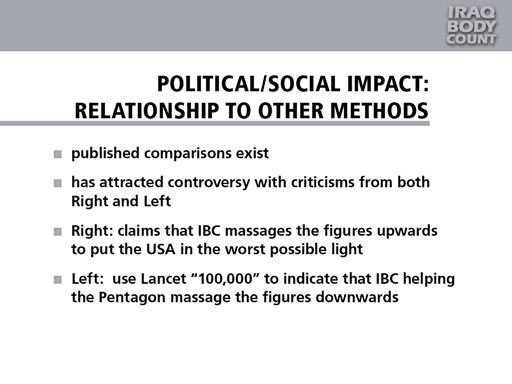In early 2006 IBC was invited to introduce its work at a Working Group Meeting on methods used by researchers to estimate armed conflict deaths (organised by the Small Arms Survey, Geneva, 17 Feb 2006).
Well-received by experts at the meeting, On Iraq Body Count summarised the project’s key features and innovations.
Political/social impact: relationship to other methods
- published comparisons exist
- has attracted controversy with criticism from both Right and Left
- Right: claims that IBC massages the figures upwards to put the USA in the worst possible light
- Left: use Lancet “100,000” to indicate that IBC helping the Pentagon massage the figures downwards
5.4 Political/social impact: relationship to other methods
-
Comparisons between our work and that of others also attempting to throw light on Iraq casualties have also appeared. One of the most straightforward is by Milan Rai, a British activist, and appears on the Iraqmortality.org web-site.1
-
Our work has also attracted its share of controversy with criticisms from both right and left:
The right accuses us of massaging the figures upwards to put the USA in the worst possible light: see, for instance "How not to count bodies" (Stephen Pollard, The Times [London], July 21 2005), which describes our total as "an entirely arbitrary figure published by political agitators".
Somewhat more surprising are approaches to our work from some sectors of the political left, who take the difference between our total and that of the "Lancet study" to indicate that we are witting or unwitting lackeys of the Pentagon in helping them massage the figures downwards: (See, for instance, "Paved with Good Intentions: Iraq Body Count" (David Edwards, Medialens.org, January 25 2006).
We are particularly surprised at this line of argument, because all but a handful of media commentaries use our figures - appropriately - as a means of highlighting the tragedy of the civilian death toll, rather than to engage in a comparison between different estimates.

